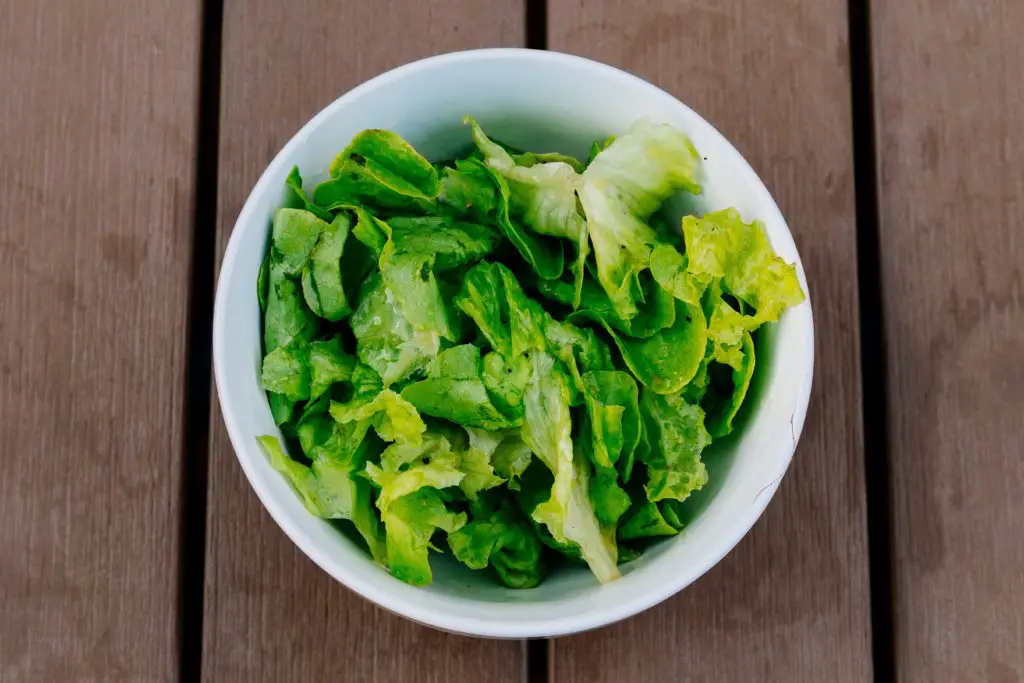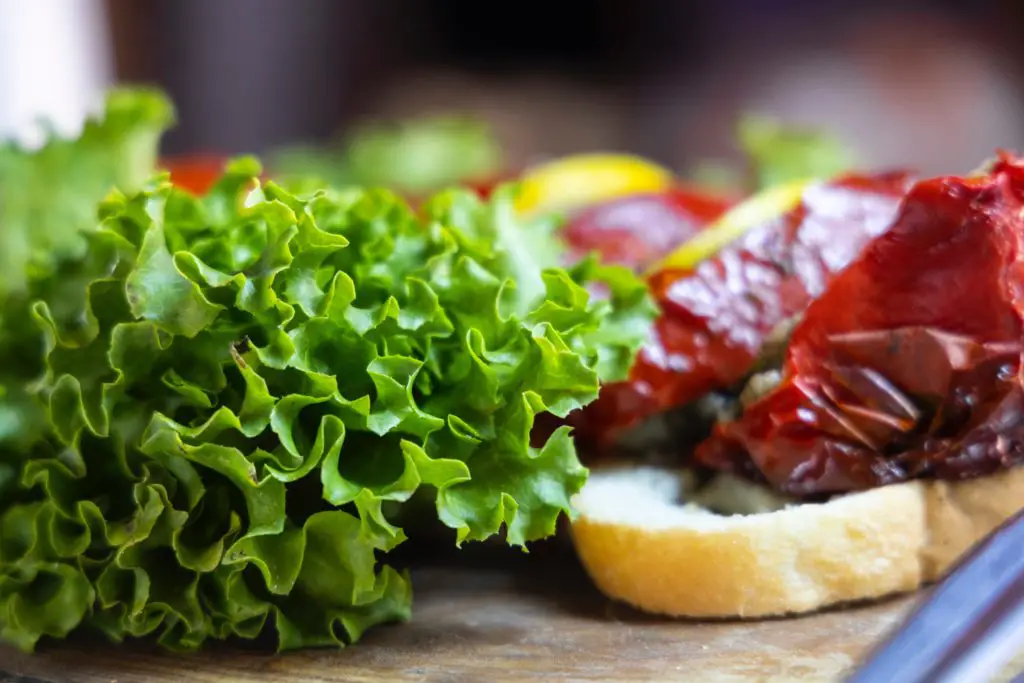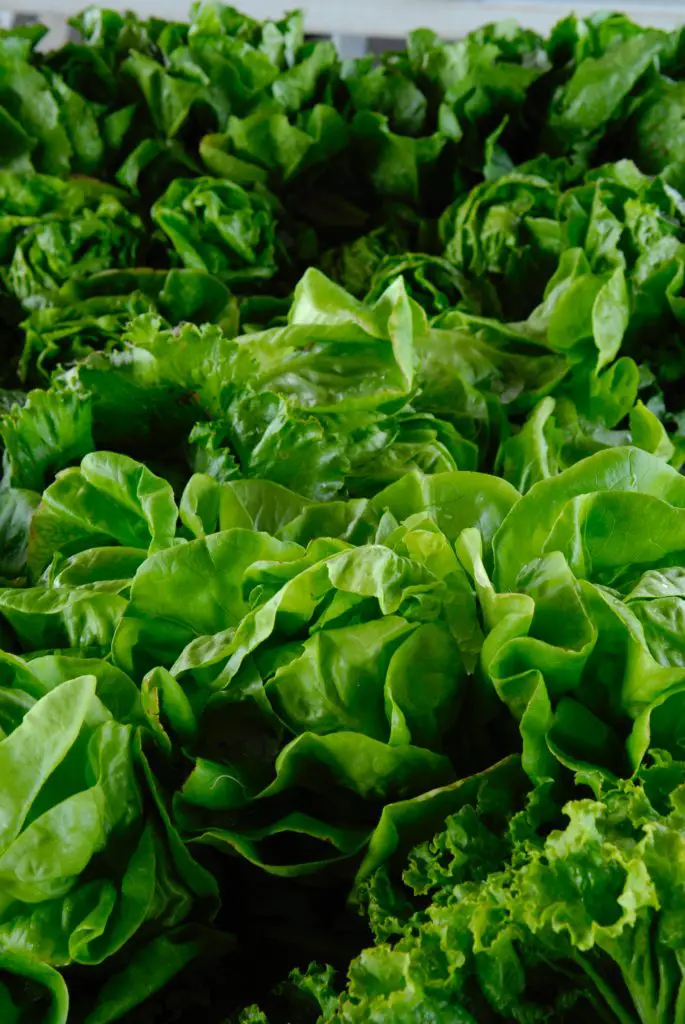Nutrient dense leafy green vegetables like lettuce are a healthy food for humans, but what about our canines? Can dogs eat lettuce? Dogs are omnivores by nature, so they eat both meat and plants. Most leafy greens like lettuce are safe for a dog to eat, in moderation.
Can dogs eat lettuce? Certain types of lettuce are safe and nutritious for a dog to consume. Romaine is the most common one that dogs can eat. Arugula, baby greens, Swiss chard, collard greens and kale are among the safe leafy greens that your dog can have on occasion.
In this article, Can Dogs Eat Lettuce, you will learn about the important nutrition found in lettuce as well as how to serve it to your dog.
- Nutritional Value of Lettuce for Canines
- Best Way to Serve Lettuce
- How Much Can My Dog Eat?
- Potential Hazards of Serving Lettuce
- Lettuce Alternatives

Related Articles:
- A Review of the 5 Best Waterless Shampoos for Dogs
- A Review Of The Top 5 Best Halloween Costumes for Dogs
- How to Stop a Dog from Pooping in the House at Night
- How to Potty Train an Older Dog in an Apartment
- How to Grind Your Dog’s Nails
Can Dogs Eat Lettuce? Nutritional Value of Lettuce for Canines
Leafy greens like lettuce are loaded with phytonutrients, vitamins, and minerals that contribute to a healthy dog. The darker the greens, the more super food nutrients it contains. Phytonutrients are the compounds that prevent and relieve illness.
Health Benefits Found in Lettuce
- Vitamin A: supports healthy coat, skin and specifically the eyes and vision.
- Vitamin C: lowers inflammation in the body, builds immunity, antioxidant properties
- Vitamin K: aids in blood clotting and coagulation.
- Magnesium: supports energy production and aids in ligament and bone maintenance.
- Calcium: supports strong bones and teeth.
- Iron: delivers oxygen to the blood and promotes energy and wellness
- Potassium: necessary electrolyte that aids in proper function of the heart, nerves, and muscles. It helps muscles contract and relax. Supports healthy kidney and heart function.
- Soluble Fiber: promotes regular elimination and healthy digestion. Maintains a healthy blood pressure.
- Antioxidants: boosts immunity and reduces inflammation.
- Glucosinolates: inhibits growth of some types of cancer.
- Low allergen food.
Related Articles:
- How to Cook Liver for Dogs
- How to Get a Picky Dog to Eat
- How to Stop Your Dog from Peeing When Excited
- How to Keep Your House from Smelling like Dog
- How to Measure a Dog for a Harness
Chlorophyll. The most well-known benefit requires a bit of detail. Leafy greens, including lettuce, contains chlorophyll, a compound that gives plants their green color. It allows plants to absorb energy from light.
The benefits of chlorophyll are numerous! Chlorophyll replenishes red blood cells, boosts immunity, cleanses, and carry’s oxygen to the dog’s organs and cells. Another important job is it aids in detoxing the liver and digestive system.
Dogs seek it out when they feel the need for better digestion. Have you ever had a dog that munched on grass? They were most likely trying to naturally supplement the compound chlorophyll.
When the dog eliminates grass, it often looks just like it went in the dog. Grass is not digestible. The difference between grass and chlorophyll found in lettuce, is lettuce can be digested by dogs.
It is this substance, chlorophyll, that prevents bad breath in dogs. Chlorophyll aids in eliminating odors in the mouth.
Can dogs eat lettuce? When chewed properly lettuce provides nutrition to the dog. The bioavailable nutrients in lettuce depend also on the variety and how it is served.

Related Articles:
- A Review of the 5 Best Slow Feed Dog Bowls
- A Review of the 5 Best Retractable Dog Leashes
- A Review of the 5 Best High Fiber Dog Foods For Anal Gland Problems
- The 5 Pawsitively Best Dog Nail Grinders
- How to Get a Dog To Take a Pill
- Learn The Secrets Of How to Clip a Dog’s Nails Safely!
Can Dogs Eat Lettuce? Best Way to Serve Lettuce
We know the answer to, can dogs eat lettuce, however what is the best way for the dog to make those nutrients available.
Buy Pesticide Free Greens. Conventional lettuce is often treated with pesticides and herbicides while growing. When possible, buy your leafy greens from a local market or buy organically grown greens.
Related Articles:
Wash Thoroughly. Wash your lettuce and pat dry. Chose how you would like to prepare the leafy greens for your dog. Always start by giving your dog a small amount when first introducing a new food.
Chop, Steam, Juice. Leafy greens can be prepared three ways for your dog, raw, juiced, or lightly steamed. Collard greens, swiss chard and kale can be easier for the dog to chew if they are steamed. However, some dogs like the crisp crunch of greens. Some dogs find enjoyment in tearing the leafy greens up before chewing it.
Prepare the lettuce the way your dog will eat it. Crispy kale and romaine lettuce might do fine chopped up. Collard greens soften with light steaming, and loose-leaf greens make a great juice.
Related Articles:
- Ultimate Guide: How To Take Care Of A Puppy
- Ultimate Guide: How To Take Care Of A Dog
- Ultimate Guide: How To Take Care Of A Senior Dog
- The Benefits of Owning a Dog
- Top 12 Tips for First Time Dog Owners
Can dogs eat lettuce? How Much Can My Dog Eat?
In the appropriate amounts, lettuce is beneficial for dogs.
Once your dog has been introduced to lettuce, you can chop, steam, or juice a one cup serving and sprinkle over their food. Dogs that gulp their food or do not chew their food well, juicing or steaming would be a better option.
Always introduce vegetables in small amounts. Fiber rich food can cause digestive upset when first adding it to their diet. One cup of collard greens contains 7 grams of fiber compared to one cup of romaine lettuce is 1 gram of fiber.
Related Articles:
- How to Cook Marrow Bones for Dogs
- A Review Of The Top Five Best Foods for Hiding Dog Pills In
- A Review of the Top 5 Best Dog Bones For Aggressive Chewers
- A Review Of The Top 5 Best Bone Broths for Dogs
- A Review Of The Top 5 Best Dog Whistles
Can dogs eat lettuce? Potential Hazards of Serving Lettuce
What could possibly be bad about giving this nutritious food to our dogs? When asked, can dogs eat lettuce, the correct answer is with caution. The hazards come in when we overfeed our dogs too much of a great food item. It could also be when we feed them directly from our plate.
Too Much Lettuce. Leafy greens are fibrous, and some types can be harder to digest. Too much fiber can cause irritation in the gastrointestinal tract leading to diarrhea. Steaming or juicing may be easier for your dog to process lettuce. Be sure to heed the recommended portion size, and not overfeed your dog.

Related Articles:
- A Review of the Top 5 Best Brooms For Dog Hair
- A Review of the 5 Best Peanut Butters for Dogs
- A Review of the 4 Best Dog Shampoos for Itchy Skin
- A Review of the 5 Best Dog Brushes For Short Hair
- A Review of the 6 Best Dog Harnesses for Hiking
No Salads. Can dogs eat lettuce? Yes. But, no salads. Lettuce is most often served in salads with other vegetables, toppings, and a flavorful dressing. Two vegetables that are toxic for dogs to consume and have potential to be on salads are onions and chives. Be extra cautious with serving your dog plain greens.
Most salad dressings are off limits to dogs due to the types of refined oils used, artificial and refined sweeteners, and heavy spices. Toppings such as croutons, walnuts, and chips are not good for a dog’s digestion.
Bacteria. Unclean lettuce can harbor bacteria such as E.coli, listeria and salmonella. Lettuce that was grown in poor soil can contain bacteria. One way to prevent your dog from exposure to bacteria is purchasing organic greens and always washing your produce well before eating.
Most dogs can consume up to a cup of leafy greens but be extra careful that your dog does not overeat lettuce. Stick to simple servings of lettuce and avoid sharing salads. Wash your greens thoroughly before serving.
Related Articles:
- The Best Canned Dog Food for Dogs with Sensitive Stomachs
- A Review Of The Top 5 Best Tactical Dog Harnesses
- How to Build an Outdoor Dog Potty Area on Concrete
- A Review of the 5 Best Dog Muzzles
- A Review Of The Top 5 Best Dog Clickers
Lettuce Alternatives
Leafy greens that are similar to lettuce but easier to digest are arugula. Arugula is lower in fiber content but high in nutrient value. Due to its slightly distinct taste, dogs may prefer arugula steamed, as it loses some of its stronger flavor.
Spinach is considered a nutritional powerhouse. Serve spinach chopped, steamed, or pureed. Dogs that are prone to kidney and bladder stones should avoid eating spinach due to its high oxalate content. A dog would have to eat a large amount of spinach to see any adverse effects, but it is best to be on the safe side.
Can dogs eat lettuce? Indeed, it is safe for dogs to eat lettuce in appropriate amounts. Dogs benefit from the soluble fiber and numerous nutrients found in lettuce. One of the best-known benefits is the chlorophyll found in lettuce. It will aid your dog’s digestion and freshen their breath.
Please read our Legal Disclaimer
